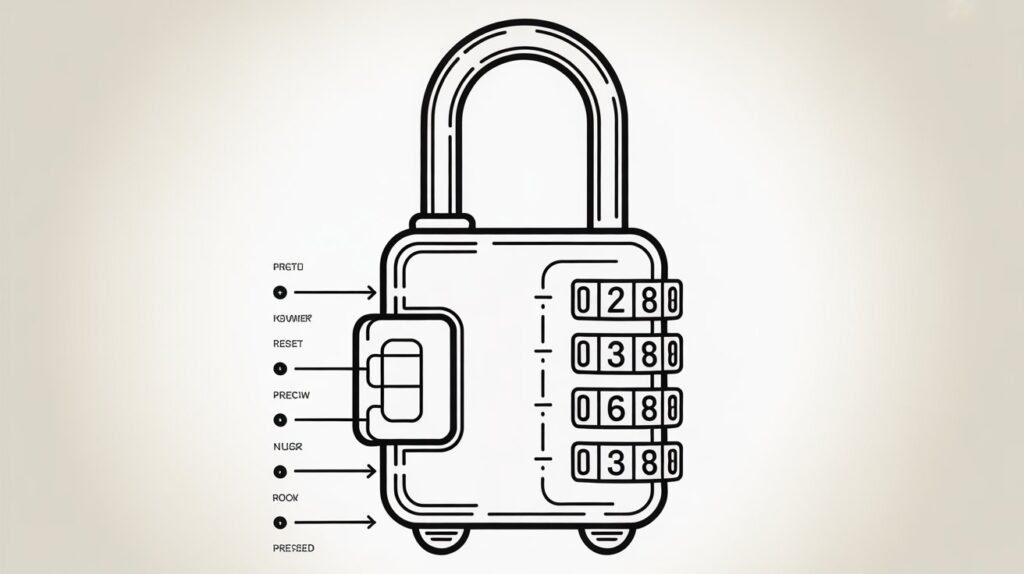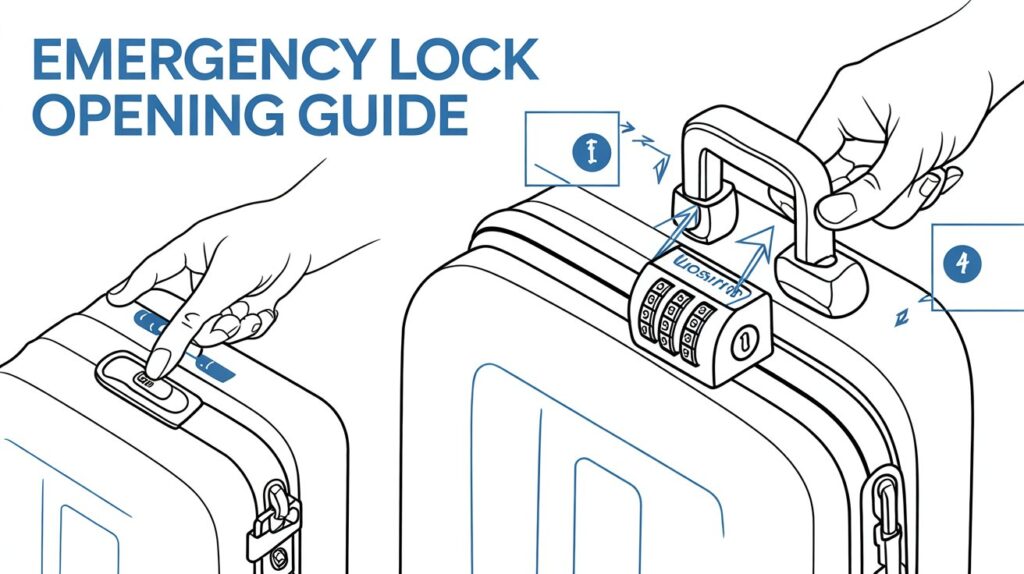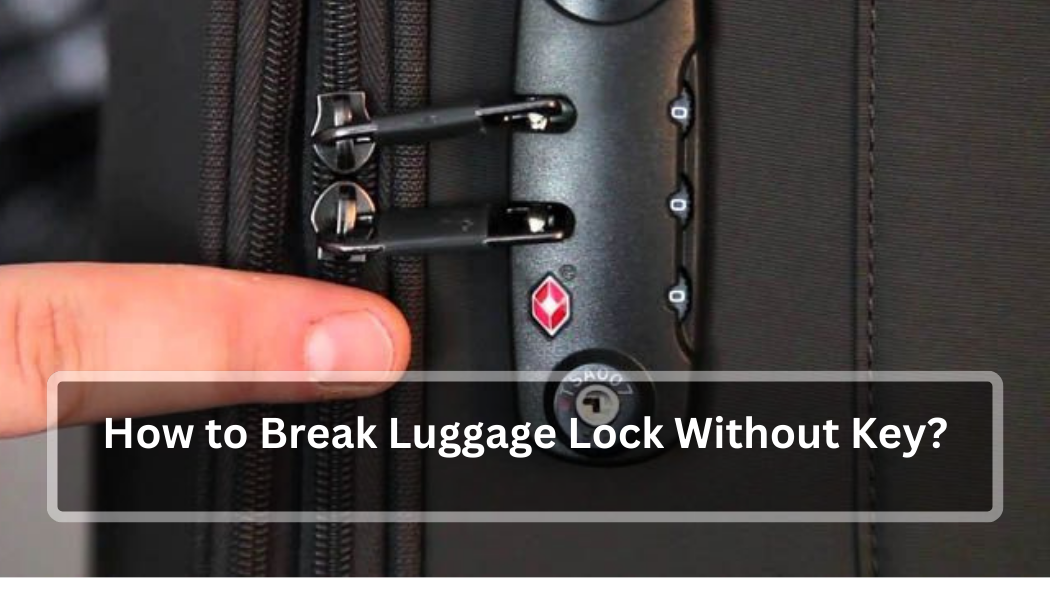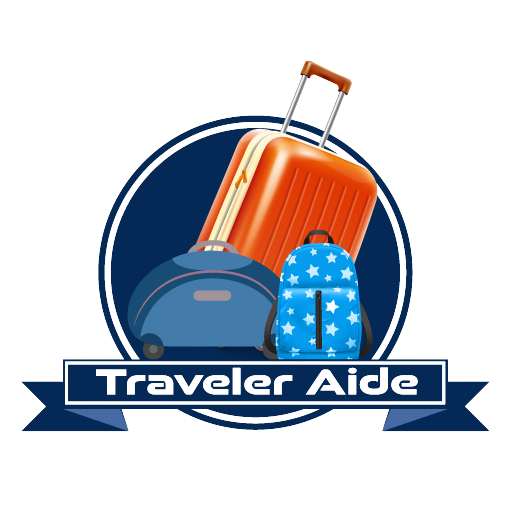I’ve dug through manuals, tested common fixes, and reviewed what professionals recommend. You can trust this guide to steer you toward the safest, most reliable ways to regain access to your own luggage.
How to break luggage lock without key? Use non-destructive options first: try default codes, feel/listen for the combination, or follow manufacturer reset steps. If those fail, hire a locksmith;
Keep reading for step-by-step non-destructive methods, brand reset tips, and safe last-resort techniques so you can choose the right option for your situation.
Non-destructive ways to open a luggage lock
When you ask How to Break Luggage Lock Without Key, start with gentle fixes. These methods keep the bag and lock intact. Try them first.

1. Try the default code
Many locks ship with a factory code. Common defaults are 000, 0000, or 123. It’s quick to check. Spin the dials slowly and try those combos. If one works, reset the code to something you’ll remember.
2. Read the manual or brand support
Top brands publish reset and recovery steps. Samsonite, Away, Tumi, and others list model-specific guides on their sites. Search the brand name plus “reset lock” or check the luggage paperwork. Manufacturer fixes are the safest option.
3. Use official TSA procedures (for TSA locks)
TSA-approved locks are meant for inspection. If your lock is TSA-type, airline or airport security can open it during screening. Some models also have official reset instructions. Contact the luggage maker or the airport lost & found for guidance.
4. Call a locksmith or luggage repair shop
A trained locksmith can open most locks without damage. Many luggage repair shops also offer non-destructive unlocking. In places where luggage specialists are scarce, general locksmiths often help. Have proof of ownership ready. This is a fast, low-risk route.
5. Airport and airline help
If you’re at the airport, ask baggage services or airline staff. They sometimes have tools or procedures to access locked bags during irregularities. Policies differ by carrier, so be prepared to show ID and ownership proof.
6. Gentle “feel and listen” approach (conceptual)
There are low-impact techniques that rely on feeling or hearing the lock mechanism while applying light opening pressure. These methods aim to discover the correct combination without force. If you try them, proceed slowly and stop if you risk damaging the lock. If unsure, skip this and call a pro.
7. Product replacement parts and keys
Some brands sell replacement keys or lock assemblies. If your lock uses a small keyed cylinder, the maker might ship a replacement part. Check official parts pages or authorized service centers.
Last-resort (destructive) options and how to limit damage
If you’ve tried every safe option and still can’t open your own bag, it’s time to accept that destruction may be necessary. Treat this as the final choice. Try the non-destructive routes first. If you must break something, plan to minimize cost and loss.
When to consider destructive methods
Only use force if:
- You own the bag and can prove it.
- You’ve exhausted reset, manufacturer, and locksmith options.
- You need immediate access (travel schedule, medical items, etc.).
If those conditions aren’t met, stop and get help from the airline, airport, or a pro.
Common destructive options (overview)
Here are the types of destructive fixes people use. I’m describing them at a high level so you can weigh each choice. I won’t walk through step-by-step bypass techniques.
- Cut the lock shackle with bolt cutters. This is quick for most external padlocks. It destroys the lock only and leaves the bag intact in most cases.
- Cut the padlock body or zipper pull. For padlocks on zipper pulls, cutting the shackle or the pull will free the zippers. You will need a replacement lock or a new zipper pull afterwards.
- Sever the zipper or seam (last resort). Cutting the zipper or a small seam gives access but damages the bag. This is truly last resort and may require sewing or patching later.
- Replace the lock assembly. Some hard-shell suitcases let you remove and swap the lock module. That can be destructive to the original lock but keeps the suitcase usable after a parts swap.
- Professional destructive removal. Locksmiths and repair shops can remove locks or cut components in a way that reduces collateral damage. They often have the right tools and experience to do the least harm.
How to minimize damage and cost
If you must be destructive, do these things first:
- Document ownership. Take photos of receipts, tags, or a purchase email. Keep your ID handy. This helps airlines, locksmiths, and any claims.
- Remove valuables. If cutting a zipper or seam, try to remove high-value items first (if possible) or move them to a safe place in the bag away from the cut line.
- Protect contents. Wrap fragile items in clothing or a towel before cutting to avoid accidental nicks.
- Cut only what’s needed. Target the lock hardware or a small zipper pull. Avoid wide cuts in fabric when possible.
- Keep removed parts. Save the destroyed lock and any cut pieces. Some shops can reuse or replace parts, and airlines sometimes log the removed lock for security records.
- Get a repair estimate. If the bag is expensive, ask a luggage repair shop whether they can replace the lock or repair a seam. Sometimes repair is cheaper than a new bag.
Safety, legal, and airline notes
- If you’re at an airport, check with airline staff first. They may have approved procedures or can hold your bag until you prove ownership.
- Never use destructive methods on a bag you don’t own. Doing so can be illegal.
- If security removed or damaged a lock during screening, contact the airline or TSA for their lost & found and claims process. Keep records and photos for a damage claim.
Proof of ownership, contacting professionals, and brand-specific tips
When you search How to Break Luggage Lock Without Key, one of the first questions people ask is about proof. That matters a lot. Shops, airports, and locksmiths will want to confirm the bag is yours. Having the right documents speeds things up and avoids trouble.
Proof of ownership — what to bring
- Purchase proof. Receipt, order email, or a photo of the original box helps.
- ID. Bring a photo ID that matches the name on the booking or receipt.
- Photos of the bag. Take close shots of brand tags, serial numbers, and any unique marks.
- Contents list. A quick list of what’s inside can help staff verify the bag.
- Warranty or service papers. If the brand offers repairs, these documents can speed a fix.
If you can’t show a receipt, don’t panic. Clear photos and a believable story often work. But be honest. Providers must avoid helping with suspected theft.
Who to contact first
- Manufacturer support. Many brands publish reset steps. Some sell replacement parts. Check their support pages or call them. They may ask for a serial or model number.
- Authorized service centers. Brands like Samsonite, Tumi, and Away have repair partners. These centers may replace a lock module or do non-destructive fixes.
- Local luggage repair shops. These shops handle zippers, locks, and handles. They often fix suitcases and can advise on the least damaging option.
- Licensed locksmiths. A locksmith is trained to open locks with minimal damage. Ask if they’ve dealt with luggage locks before.
- Airport baggage services. If you’re at the airport, talk to airline staff before attempting any fix. They can offer help or advise on claims if screening damaged the bag.
What to ask a professional
- “Can you open this without damaging the bag?”
- “Do you offer a repair after opening?”
- “What proof do you need?”
- “Do you charge for an estimate?”
- “How long will it take?”
These simple questions help you compare options fast.
Brand-specific notes (quick)
- Samsonite: Many models let you reset the code with a known sequence. Their support often lists step-by-step resets.
- Away: Popular guides explain resetting and removing the lock module for some hard-shell models. Check official pages first.
- Tumi: High-end brands often offer service centers and part replacement. Contact Tumi support for model-specific help.
- Generic padlocks: If your lock is an external padlock, replacing the lock is often simpler than repairing the zipper.
Costs and time expectations
- Non-destructive help from a repair shop or locksmith usually costs less than replacing an entire suitcase.
- Basic locksmith work or a simple part swap can often be done the same day.
- Major repairs or shipping to a brand service center can take days to weeks.
- If you’re traveling, prioritize options that return your bag quickly—airline baggage, local shops, or locksmiths tend to be faster.
Step-by-step guide, prevention tips, and wrap-up
At this point, you’ve learned the non-destructive methods, the last-resort options, and how to involve professionals safely. Here’s a simple roadmap you can follow whenever you’re locked out.

Step-by-step decision guide
- Identify your lock type – combination, key, TSA-approved, or padlock.
- Try non-destructive methods first – default codes, feel/listen techniques, or brand reset instructions.
- Contact professionals if stuck – manufacturer, authorized service centers, local repair shops, or locksmiths.
- Use destructive methods only if necessary – bolt cutters, zipper pull cuts, or lock module replacement. Always protect the contents and minimize damage.
- Document everything – proof of ownership, photos, and receipts help in case of disputes or claims.
Prevention tips for the future
- Write down your code in a safe place or store it in your phone.
- Regularly maintain your locks and zippers; keep them clean and lubricated.
- Consider TSA-approved locks when traveling by air—they allow inspections without damage.
- Avoid using low-quality locks for valuable items; invest in durable locks or suitcases with built-in resettable options.
Wrap-up
Breaking a luggage lock without a key can sound scary, but with the right approach, it doesn’t have to be. Start gentle, call for professional help if needed, and only destroy as a last resort. By following these steps, you’ll regain access to your bag safely and efficiently.
Frequently Asked Questions Of How To Break Luggage Lock Without Key?
Are Luggage Locks Easy To Break?
Luggage locks can vary in terms of their security levels. Many new luggage locks are designed to be secure and hard to tamper with, unlike cheaper locks. It’s important to invest in a quality lock to ensure the safety of your belongings.
Can Tsa Break Suitcase Locks?
Tsa can break suitcase locks during the inspection process for security reasons.
Can You Get A Tsa Master Key?
TSA master keys, also known as TSA-approved locks, are used by security personnel to access luggage during security checks. However, these keys are not typically available to the public. TSA-approved locks have a special mechanism. It lets security open them with master keys without damaging the lock.
To keep your luggage safe, use a TSA-approved lock. It protects against damage and inspections.
How Can I Break A Luggage Lock Without A Key?
Breaking a luggage lock without a key is not recommended as it may damage your luggage. But in an emergency, you can use a screwdriver or hairpin to open the lock.
Conclusion
To sum up, there are various effective methods for breaking a luggage lock without a key. To succeed, be cautious and accurate when using tools or lockpicking methods. When choosing a method, consider your situation, resources, lock type, and comfort level.
Please use these methods responsibly. Only use them when you legally own or have permission to access the locked luggage. To deal with locked luggage, read the tips in this blog post. They are helpful.
Next time you need to open a locked luggage without a key, you’ll have the knowledge and tools to do it.
Hi there! I’m a Travel Advisor, and I’m a seasoned traveler with a passion for exploring new and exciting destinations. I have visited the heritage sites of several countries and have learned a thing or two about traveling the world in style and comfort.
My expertise lies in finding the perfect balance between luxury and adventure, and I’m always on the hunt for new and unique experiences. I believe that travel should be about creating meaningful connections and cultural exchanges, and I strive to make a positive impact wherever I go.
With 15 years of experience in the travel industry and a wealth of knowledge about destinations near and far, I’m confident in my ability to help plan the perfect trip for any type of traveler. Whether you’re looking for an exotic beach getaway, a bustling city escape, or an adventure-filled road trip, I’ve got you covered.


